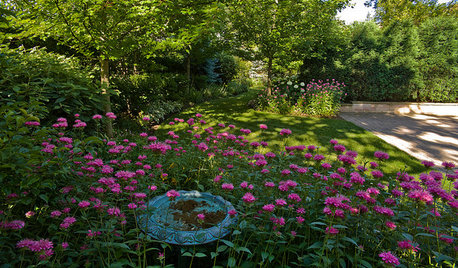How to care for a lawn with Red Thread
claga
9 years ago
Related Stories

RUGSCool Threads: Shag Rugs Stage a Comeback
See Why You May Want to Sink Your Toes Into Some Deep-Pile Carpet Again
Full Story
LANDSCAPE DESIGNGet Along With Less Lawn — Ideas to Save Water and Effort
Ditch the mower and lower your water bill while creating a feast for the eyes with diverse plantings and gathering places
Full Story
LANDSCAPE DESIGN7 Low-Maintenance Lawn Alternatives
Turf isn't the only ground cover in town. Get a lush no-grass lawn with clover, moss and other easy-care plants
Full Story
BEFORE AND AFTERSSee 6 Yards Transformed by Losing Their Lawns
Wondering whether a turf lawn is the best use of your outdoor space? These homeowners did, and they found creative alternatives
Full Story
FRONT YARD IDEASBefore and After: Front Lawn to Prairie Garden
How they did it: Homeowners create a plan, stick to it and keep the neighbors (and wildlife) in mind
Full Story
SAVING WATERHouzz Call: Are You Letting Go of Your Lawn?
Many facing a drought are swapping turf for less thirsty plantings. If you’re one of them, we’d like to hear about it
Full Story
GARDENING GUIDESHow to Fix Bare and Yellow Lawn Spots
Restore your turf’s good looks by reseeding unsightly patches
Full Story
LIGHTINGHouse Hunting? Look Carefully at the Light
Consider windows, skylights and the sun in any potential home, lest you end up facing down the dark
Full Story
GARDENING GUIDESTree Care: Common Tree Diseases and What to Do About Them
Learn to recognize trees that may be affected by diseases or pests so you can quickly take action
Full Story
LANDSCAPE DESIGNExuberant Self-Seeders for Gorgeous, Easy-Care Gardens
Keep weeds down, color high and maintenance low with beautful plants that sow themselves
Full StoryMore Discussions








dchall_san_antonio
clagaOriginal Author
Related Professionals
Maple Valley Landscape Architects & Landscape Designers · Roxbury Crossing Landscape Architects & Landscape Designers · Bethlehem Landscape Contractors · Stoughton Landscape Contractors · Dallas Landscape Contractors · Hoffman Estates Landscape Contractors · Lees Summit Landscape Contractors · North Richland Hills Landscape Contractors · Saint George Landscape Contractors · Shoreview Landscape Contractors · Wareham Landscape Contractors · Woodbury Landscape Contractors · Bensenville Landscape Contractors · Grand Rapids Swimming Pool Builders · West Chester Swimming Pool Buildersdchall_san_antonio
danielj_2009
morpheuspa (6B/7A, E. PA)
clagaOriginal Author
morpheuspa (6B/7A, E. PA)
danielj_2009